Your chickens will need extra care and attention if elevated temperatures and heavy humidity is the forecast. Even backyard chickens need help to remain cool on hot summer days.
Because birds cannot sweat, they can quickly overheat, but it doesn’t take much to provide chickens with conditions where high temperatures do not harm their health.
Shade, water, and efficient ventilation are the three most basic requirements needed to keep your chickens cool and comfortable during the summer heat.
Continue reading for some simple tips that will help you keep your chickens cool all summer long.
Pay Attention
Chickens can survive in a wide range of temperatures, but they perform at their best when it’s 75°F (23.8°C) or less outside.
We recommend you start to make conditions chilly for your chickens when the temperature reaches 75 to 80°F (23.8 to 26.6°C). Temperatures of 100°F (37.7°C) or above can be quite fatal for your birds.
While hot weather is undoubtedly negative for your chickens, the most serious risk to their health is when high temperatures and excessive humidity combine.
A chicken will suffer from heat stroke if its body temperature rises to a life-threatening level, and it is unable to cool down fast enough. Lack of fluids and the body’s rising temperature will cause the chicken’s organs to stop functioning, eventually leading to death.
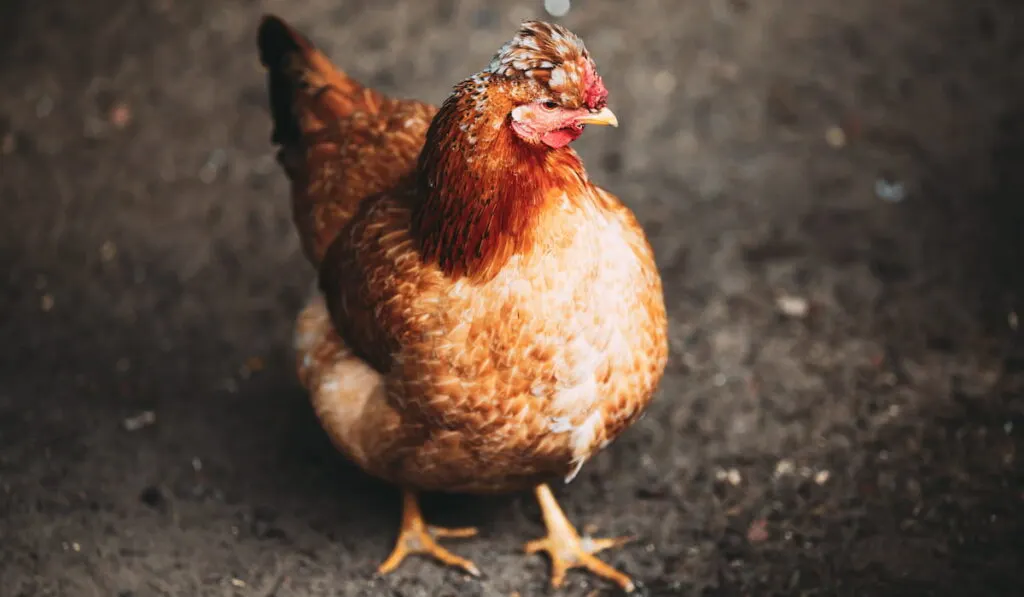
Chickens don’t have sweat glands like us, so they cool down by letting out air. If your chickens are panting heavily, this is a sure sign they are overheating.
A second common symptom that your chickens are trying to beat the heat is when they spread their wings as far from their bodies as possible in an effort to cool down.
So, if your chickens are overheating, you’ll notice some of the following symptoms:
- panting
- holding their wings away from their bodies
- increased water intake
- decreased feed intake
- smaller eggs
- reduced laying capacity
- thin, fragile eggshells
- pale wattles and comb
- drooping
- lethargic
First Aid for Chickens With Heat Stroke or Heat Exhaustion
- Place your chicken immediately in a cool place
- Prepare a cool bath. Dip the chicken’s body to the neck in cool but not icy water.
- Give your chicken electrolytes.
Always call your vet for help if your animal’s health is in danger.
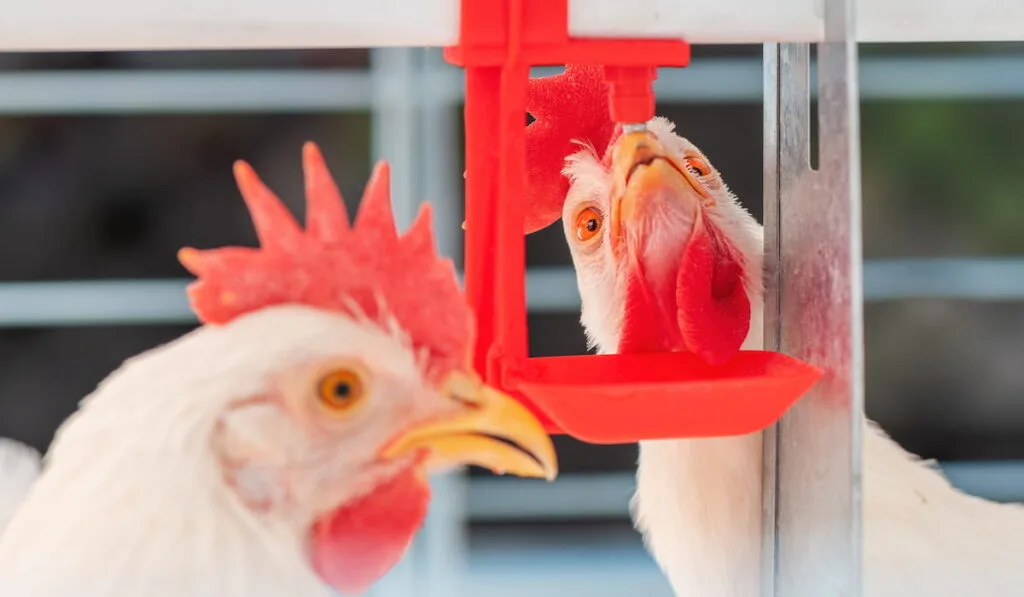
Table of Contents
1. Fresh Water
You can always count on water.
During the scorching summer months, chickens must have unlimited access to fresh water to stay hydrated.
You may need to refill your chickens’ water containers several times during the warmest parts of the day. If you let the water sit for too long, it can become smelly and dirty.
Using a chicken water feeder or watering nipples is a simple way to keep the water clean and prevent it from growing stale too quickly or tipping over.
When compared to the standard chicken watering devices, feeders and nipples are significant improvements. Cleaning dirty water containers and keeping track of water levels will become less hassle.
Your chickens will have enough to drink if there are several water sources in shady, cool places.
Add some ice cubes to the water for maximum chill. You can also use frozen foods, such as fruits and vegetables, instead of ice.
2. Electrolytes
Birds try to cool down when exposed to high temperatures by raising their breathing rate from 25 to 250 times per minute! But excessive panting results in a loss of electrolytes, including sodium and potassium.
These electrolytes are necessary for the chickens to retain water. So, in addition to purified water, electrolytes should be given to the flock to keep it hydrated.
Electrolyte therapy reduces the harmful effects of heat stress and increases feed intake.
You can buy an electrolyte supplement or use a few common ingredients to make a simple solution.
Products of choice:
- PlusVet Qingdao Animal Health, SupraPlus©
- PlusVet Qingdao Animal Health, PhytoShield©
- Sav-A-Chick, Vitamins & Electrolytes
- Durvet, Vitamins, and Electrolytes for Poultry
Recipe for the chicken electrolyte solution:
- Three liters of water
- Eight tablespoons of sugar
- Half a teaspoon of salt, table salt, or sea salt
- Half a teaspoon of baking soda
- Half a teaspoon of potassium chloride (optional)
Follow the manufacturer’s directions when administering the use of electrolytes to your birds and talk to your vet before trying an Electrolyte DIY solution.
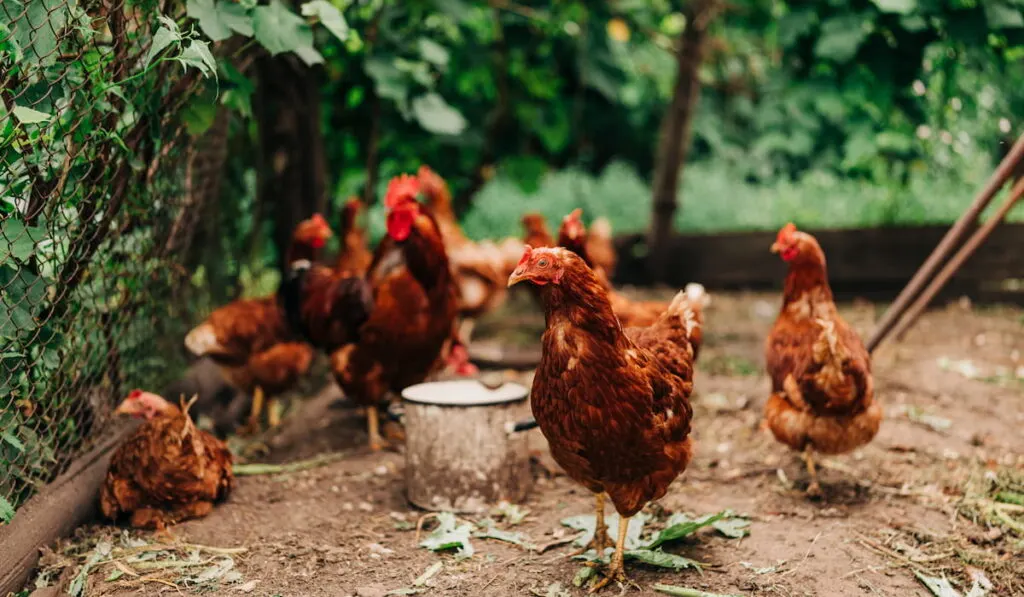
3. Extra Shade
When it gets too hot, chickens should have a place to hide from the sun. Natural plant cover will provide shade, and so are artificial structures which can be designed for the same task.
The shade provided by shrubs and plants in an aviary is much appreciated. The chickens will have natural shade under the overhanging branches of shrubs and trees planted around their enclosure.
In the absence of suitable plant cover, a shade screen or a partially covered pen may be necessary to shield the birds from the sun.
Tarps or dark shade cloths are a quick and easy way to provide shade for birds. Proper placement of something as simple as an old umbrella can also serve the purpose of providing shade.
If you cover the pen, ensure the wind can blow through it, as the chickens will appreciate a pleasant, cool breeze.
Your chickens must have a cool place to hang out whenever it’s hot outside, and it needs to be big enough for the whole flock.
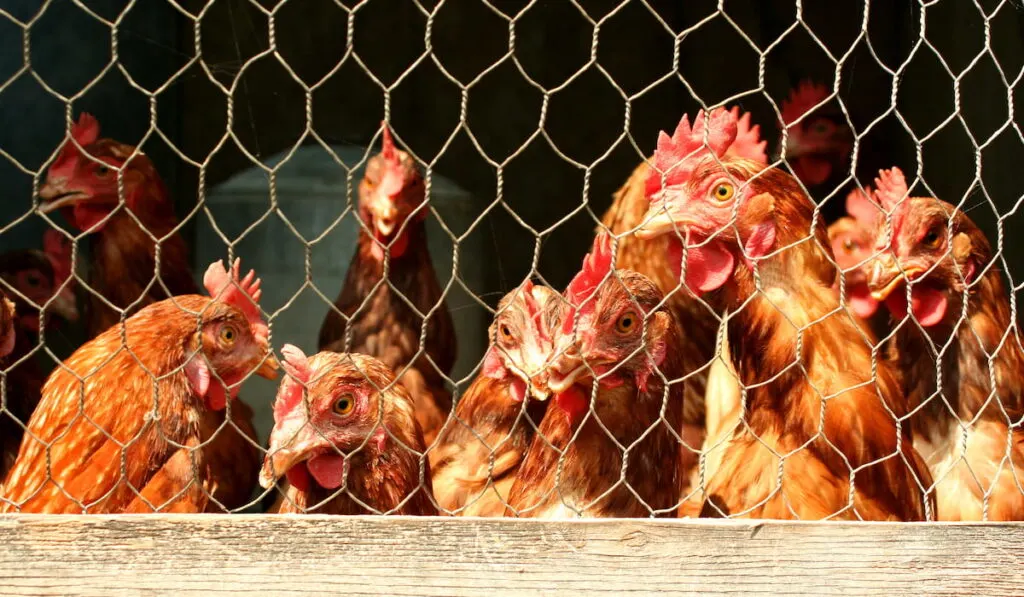
4. Chicken Coop Ventilation
Proper ventilation that allows lots of fresh air to circulate through the coop is key to the birds’ health and should be maintained all year.
The two primary goals of ventilation in your chicken coop are:
- Exchange of air, in which stale air, carbon dioxide, dust, moisture, and ammonia vapors are removed and replaced with fresh air.
- Air circulation, which distributes fresh air throughout the coop.
You should ensure there are enough windows, doors, vents, and other openings around the coop to let fresh air enter.
A decent rule of thumb for sizing ventilation in a coop is 1 square foot for every 10 square feet of floor space.
It is also beneficial to put cooling fans in your coop. Your chickens will love a fan in the coop since it will allow them to enjoy the cool air while curled up and relaxing.
Remember that if you add windows or doors for ventilation, you must install a metal grate to keep out predators.
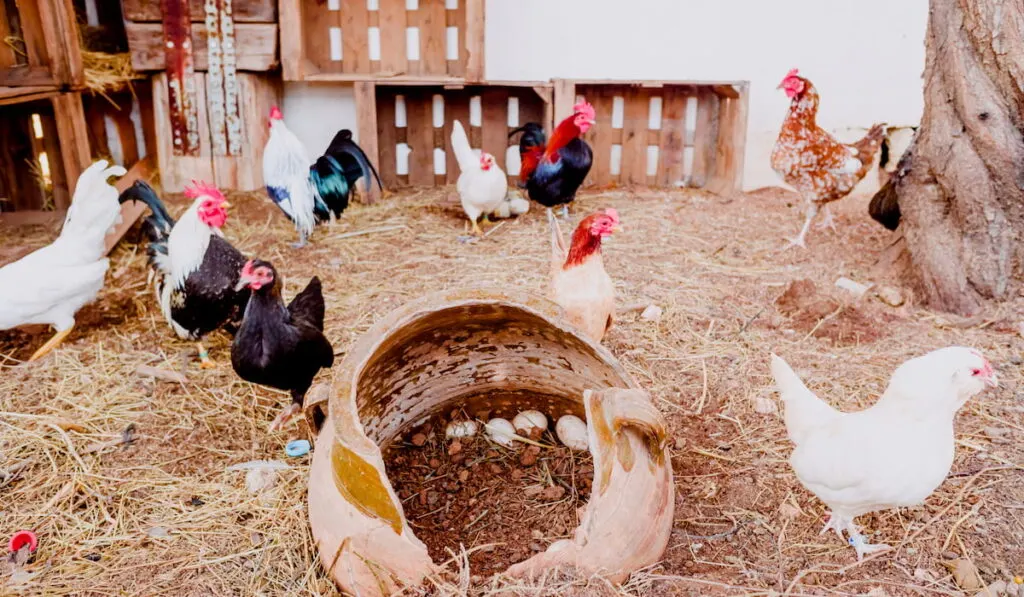
5. Avoid Overcrowding
When too many chickens are in a small space, their body temperature is amplified by the heat of the whole flock.
The heat generated by overcrowded chickens is enough to cause heat stress, but adding hot weather to the mix can be fatal.
Too many chickens in a confined space can also lead to fights and even cannibalism.
If you want your chickens to live in peace and not overheat, you’ll need to provide them with plenty of room to roam and play.
Enclosure Space
Allow at least 8 square feet of enclosure space per bird if your chickens must be confined during the summer.
Chicken Coop Space
The minimum space needed for a chicken coop is three square feet per bird.
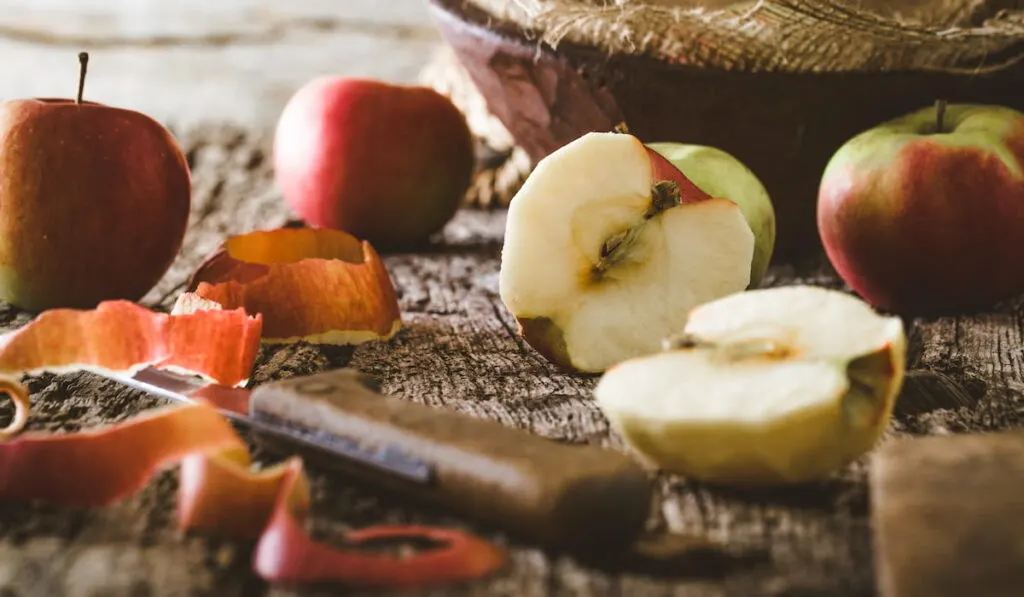
6. Frozen Treats
In addition to providing plenty of shade and cool water, you can also give your chickens some refreshing treats to help them cool down and replenish some of the fluids they lose on hot summer days.
In the poultry world, watermelon is considered a top-tier treat. Juicy and sweet, it quenches thirst and aids hydration on hot days.
To maximize the benefits of watermelon, cut it into small pieces and put it in the freezer.
Keep your chicken happy and healthy with these frozen treats. They are ready to eat straight out of the freezer or when placed in a water bowl.
Other fruits and vegetable suggestions that you can use with remarkable success include:
- Frozen cucumber slices
- Frozen cantaloupe pieces
- Frozen berries
- Frozen green peas
- Frozen apple peel
7. Mist Sprays
Misters are a worthwhile investment when summer temperatures are soaring. In a short amount of time, a mister can decrease the temperature by up to 30 degrees!
You can get a simple mister that stands independently and connects to a garden hose for relatively little money from your neighborhood garden store. It is a quick and highly effective method for fighting heat. Additionally, it helps to supply water to your chicken even when you are not around.
Place the mister in a shady spot and let it do its job. A patch of damp mud or sand on a hot day can feel like a mini spa for your birds.
It is not difficult to set up a permanent misting system, either. It can be set to turn on at specific times of the day and would be the perfect addition to the chicken run.
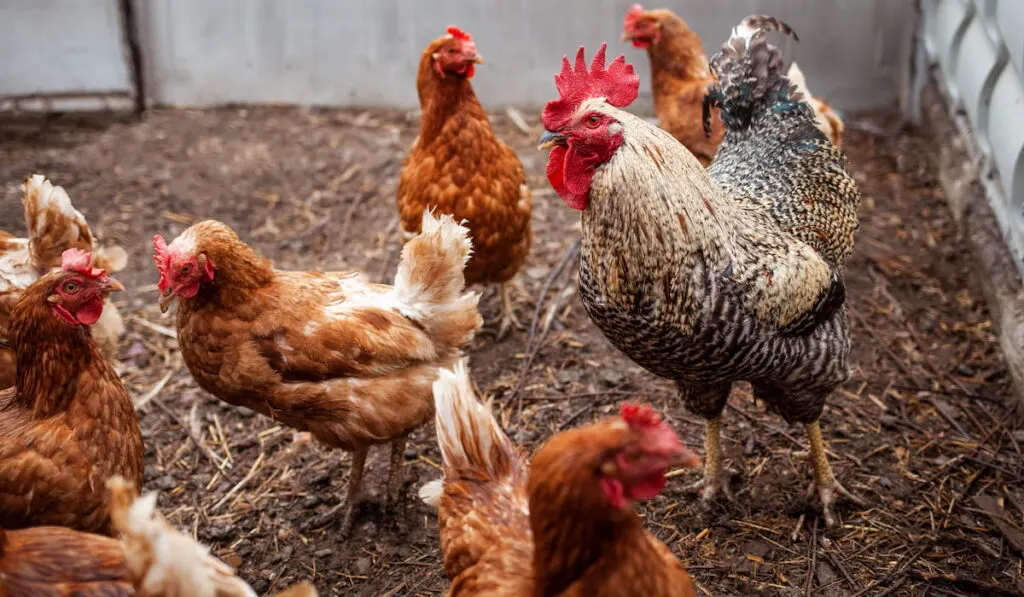
8. Dust Baths
Although it may seem odd, chickens actually have an excellent reason for taking dust baths.
Chickens benefit from regular dust baths because it keeps their feathers clean and helps to minimize parasites. There is, however, another reason chickens like a good, dusty bath. It helps them cool off on a hot day.
Try watering their dust bath area, so it is cold and moist for extra pleasure.
Final Thoughts
When the weather gets hot, your chickens can only rely on you to help cool them off.
It is important to keep your birds cool, comfortable, and safe during those summer feverish temperatures.
Keep in mind that water and shade are your best friends when it comes to beating the heat. You’ll be well on your way to success if you give your chickens as much of them as possible.
Resources
- https://www.raising-happy-chickens.com/keep-chickens-cool.html
- https://www.mannapro.com/homestead/bid/148206/top-8-tips-for-keeping-your-backyard-chickens-cool-in-the-summer
- https://poultry.extension.org/articles/poultry-management/managing-backyard-chickens-during-extreme-summer-temperatures/
- https://plusvet.eu/2022/05/03/electrolyte-therapy-essential-during-heat-stress/
- https://www.dineachook.com.au/blog/what-is-the-best-chicken-drinker-is-there-a-difference/
- https://petkeen.com/best-chicken-waterer/
- https://plusvet.eu/2022/05/03/electrolyte-therapy-essential-during-heat-stress/
- https://plusvet.eu/supraplus/
- https://plusvet.eu/phytoshield/
- https://www.wood-enterprises.com/70savachickvande.html
- https://www.drugs.com/vet/vitamins-electrolytes-for-poultry.html
- https://merricks.com/product/poultry-electrolytes/
- https://www.durvet.com/product/vitamins-electrolytes-100-gm/
- https://www.thegoodlifebackyard.com.au/homemade-chicken-electrolytes/
- https://www.thehappychickencoop.com/how-much-room-do-chickens-need/
- https://www.thepioneerchicks.com/9-summer-treats-for-chickens-beat-the-heat/
- https://the-chicken-chick.com/chicken-dust-baths-ultimate-spa/
